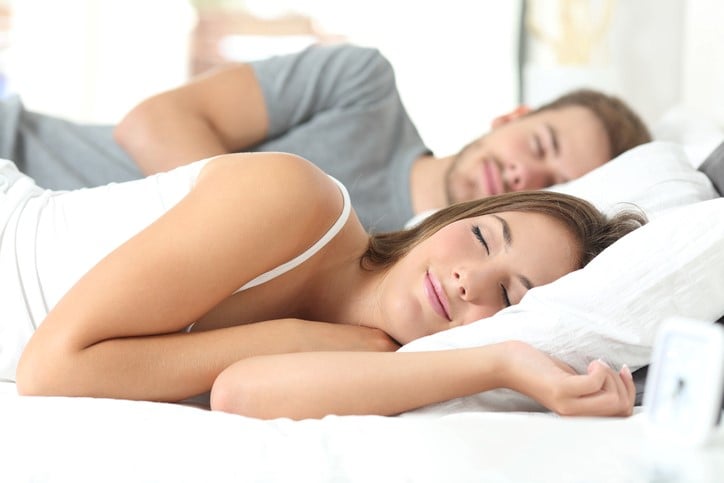If you've ever suffered from back pain, you know how uncomfortable it can be.
It can be downright miserable.
Unlike most injuries, having low back pain affects all aspects of our life.
Doing the most ordinary and mundane things become increasingly challenging when you have low back pain.
When you put your shoes on this morning, did you have to think twice about it, or did you just do it?
With low back pain, you aren't fortunate enough to "just do it."
Even putting your shoes on requires a lot of effort and can put you in a great deal of pain.
Sometimes, if the pain is severe enough, you'll even need help getting them on.
Finding a comfortable sleep position and getting restful sleep is another seemingly effortless activity we take for granted when people aren't searching for lower back pain relief.
When you do have low back pain, it's possible to wake up in even more pain than when you went to sleep if you don't sleep properly.
After sleeping, you should feel refreshed and rejuvenated, not sore and exhausted. A lack of sleep can wears your body down over time and makes things worse. Chronic pain can lead to other medical conditions issues down the road, sometimes even nerve pain.
That's why it is crucial to sleep in a way that will help your low back pain, not worsen it.
Below we'll go over some of the best sleeping positions to use while you have low back pain to help you sleep like a baby.
Table Of Contents
- On Your Back With Knee Support
- On Your Side In The Fetal Position
- On Your Stomach With A Pillow Under Your Abs
- On Your Stomach, Face Down
- On Your Back, In a Reclined Position
- On Your Side With A Pillow Between Your Knees
- Get Some Quality Sleep
On Your Back With Knee Support
Sleeping flat in a neutral position on your back is generally considered to be the best sleeping position to keep a healthy back.
Sleeping on your back distributes your weight evenly and minimizes pressure points, while encouraging your spine's natural curvature.
It also ensures proper alignment of your head, neck, and spine.
Placing a small and supportive pillow under your knees makes it even better.
The pillow will provide additional support and help maintain the natural curve of the spine while reducing any muscle tension.
Using this sleeping position is relatively easy and typically results in better quality of sleep.
All you need to do is lay flat on your back, looking at the ceiling. Don't twist your head to either side.
Then, simply place a pillow directly under the kneed, and you're all set.
If you feel like you still need additional support, you can put an extra pillow in any more gaps you have between you and your mattress.
On Your Side In The Fetal Position
Sleeping in the fetal position is especially useful for people with herniated disc pain.
You probably already know how to get in the fetal position, but if you're unfamiliar, lay on your side, curl your knees toward your chest, and bend your torso toward your knees.
Your discs are soft cushions found between the vertebrae in your spine.
When you have a herniated disc, the disc has pushed out of its normal space, causing pain and weakness in your back.
Sleeping in a curled-up fetal position opens the space between your vertebrae, providing relief from the pain.

On Your Stomach With A Pillow Under Your Abs
If you ask the experts, they will probably tell you that sleeping on your stomach is the worst popular sleep position to sleep in for your back.
If you're struggling to sleep in the other positions, though, putting a pillow under your abs will help improve spinal alignment while creating a comfortable sleep environment.
Sleeping on your stomach may also provide relief to people with a herniated disc or degenerative disc disease and even relief shoulder pain.
When you sleep in this position, make sure you put a thin, slim pillow under your abs.
You should also use a flat pillow for your head, or consider not using one at all for best sleep quality while on your tummy. The thinnest pillow that you can find, is the best.
On Your Stomach, Face Down
One of the main reasons sleeping on your stomach is considered one of the worst sleeping positions for your back is because you turn your head to the side and creates undue pressure and muscle tension.
Twisting your neck puts added stress and muscle strain on your neck, shoulders, and spine.
The fix for this is simple; sleep face down. It sounds like an awkward sleeping position, but a lot of people have found relief from chronic back, and even neck pain.
Putting a small pillow, or a tightly rolled towel under your forehead will provide adequate breathing space.
Do this in addition to sleeping with the pillow under your abs.
On Your Back, In a Reclined Position
If you find yourself continually falling asleep in your recliner, this is the position for you.
Sleeping in a chair isn't the best choice for back pain, but you can recline yourself in your bed to achieve the same effect.
Buying an adjustable bed will provide you with the best alignment and support.
Sleeping reclined is good for your back because it creates an angle between your thighs and your core, helping to reduce the pressure on your spine.
Bonus, if you suffer from gastroesophageal reflux disease (GERD), it can help relieve symptoms.
On Your Side With A Pillow Between Your Knees
Sleeping on your side is a very popular position preferred by many people.
However, it is likely to pull your spine out of position straining the lower back.
Thankfully, this is easy to correct.
All you have to do is put a firm pillow between your knees.
This raises your upper leg, restoring the natural alignment of your hips, pelvis, and spine.
If you love sleeping on your side, just bend your knees slightly, put a firm pillow between your legs, and you're all set.
If you typically start on your side but eventually end up on your stomach, you can try hugging a large pillow against your chest to keep you in place and properly aligned.
Get Some Quality Sleep
If you have back pain, especially chronic back pain, give these different positions and alignment tips a try.
The last thing you need if you have low back pain is to toss and turn all night, or sleep in a way that worsens your pain.
Try out all of these positions until you find the position that is best for you.
If you enjoyed this article, you should check these out:

